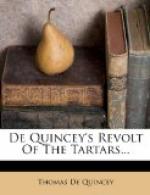25 26. malignant counsels. What is the full effect of this epithet?
26 10. valedictory vengeance. Note again the force of the epithet.
26 28. aggravate. What is the literal significance of this word? As synonymous with what words is it often incorrectly used?
28 11. For now began to unroll. Does this paragraph constitute a digression, or is it a useful amplification of the narrative? Does De Quincey exaggerate when he terms these experiences of the Tartars “the most awful series of calamities anywhere recorded”?
28 14. sudden inroads. “The inroads of the Huns into Europe extended from the third century into the fifth; those of the Avars from the sixth century to the eighth or ninth; the first great conquests of the Mongol Tartars were by Genghis-Khan, the founder of a Mongol empire which stretched, in the beginning of the thirteenth century, from China to Poland.”—MASSON.
28 18. volleying lightning. Compare p. 2, l. 1, where De Quincey uses a somewhat similar phrase. Why is the phrase varied, do you suppose?
28 21. the French retreat. It would be interesting to compare the incidents and figures of this retreat, as furnished by biographers and historians. Sloane’s Life of Napoleon is a recent authority.
28 26. vials of wrath. Compare Revelation, xv, 7, and xvi, 1. If De Quincey had used the Revised Version he would have written bowls instead of vials. Such borrowings of phrase or incident are called “allusions.” Make a list of the scriptural allusions found in the essay,—of those suggested by Milton.
29 16. Earthquakes. “De Quincey here refers to such destructive shocks as that which occurred at Sparta, 464 B.C., in which, according to Thirlwall, 20,000 persons perished; that which Gibbon speaks of during the reign of Valentinian, 365 A.D., in which 50,000 persons lost their lives at Alexandria alone; that in the reign of Justinian, 526 A.D., in which 250,000 persons were crushed by falling walls; others in Jamaica, 1692 A.D.; at Lisbon, 1755 A.D., with loss of 30,000 lives; and in Venezuela, 1812 A.D., when Caraccas was destroyed, and 20,000 souls perished.”—WAUCHOPE.
29 20. pestilence. Described by Thucydides; see also Grote’s History of Greece, Chap. XLIX. Of the great plague of London (1665) the most realistic description is Defoe’s Journal of the Plague Year.
29 28. The siege of Jerusalem. Read Josephus, The Jewish War, Bks. V and VI.
29 31. exasperation. Compare note on p. 26, l. 28.
30 3, 4. even of maternal love. The reference is to an incident mentioned by Josephus (The Jewish War, Bk. VI, Chap. III), in which a mother is described as driven by the stress of famine to kill and devour her own child.
30 5. romantic misery. How romantic? Compare this phrase with similar uses of the word romantic.




